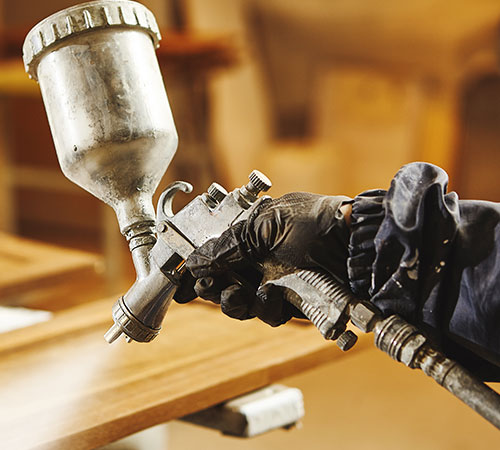Centaur Equinecisers / Powder Coating
Powder Coating
Powder coating is the fastest-growing finishing technology in North America, representing over 10% of all industrial finishing applications.

What is Powder Coating?
Powder coating is an advanced method of applying a decorative and protective finish to a wide range of materials and products that are used by both industries and consumers. The powder used for the process is a mixture of finely ground particles of pigment and resin, which is sprayed onto a surface to be coated. The charged powder particles adhere to the electrically grounded surfaces until heated and fused into a smooth coating in a curing oven. The result is a uniform, durable, high-quality, and attractive finish. Powder coating is the fastest-growing finishing technology in North America, representing over 10% of all industrial finishing applications.
What Are Its Advantages?
More Durable
Powder coating gives consumers, businesses, and industry one of the most economical, longest-lasting, and most color-durable quality finishes available. Powder coated surfaces are more resistant to chipping, scratching, fading, and wearing than other finishes. Color selection is virtually unlimited with high and low gloss, metallic, and clear finishes available. And colors stay bright and vibrant longer. Texture selections range from smooth surfaces to a wrinkled or matte finish, and rough textures designed for hiding surface imperfections.
Protext the Environment
Powder coating is also highly protective of our environment. While liquid finishes contain solvents which have pollutants known as volatile organic compounds (VOCs), powder coating contains no solvents and releases negligible amounts, if any, of VOCs into the atmosphere. Thus, there is no longer a need for finishers to buy costly pollution control equipment. In addition, most powder coating overspray that does not adhere to the part can be retrieved and reused, virtually eliminating the waste commonly found in liquid finishing processes.
Saves Money
Elimination of VOCs and reduction of wastes saves money and helps companies comply more easily and economically with the regulations of the U.S. Environmental Protection Agency. In fact, one of the major elements in expanding the market for powder coating has been the implementation over the past 30 years of stringent air pollution control legislation.
Where Is Powder Coating Used?
Appliances
The appliance industry benefits from powder coating on front and side panels of ranges and refrigerators, washer tops and lids, dryer drums, air-conditioner cabinets, water heaters, dishwasher racks, and cavities of microwave ovens. Powder coating has also replaced porcelain enamel on many washer and dryer parts.
Automotive
The automotive industry uses powder coating on wheels, bumpers, hubcaps, door handles, decorative trim and accent parts, truck beds, radiators, filters, and numerous engine parts. A clean powder topcoat has been developed to protect auto bodies. BMW and Volvo are using it on their new model cars, and GM, Ford, and Chrysler have formed a consortium to test this technique on their production lines.
Architecture/Building
The architectural and building market powder coats aluminum extrusions used on frames for windows and doors and modular furniture. Many highway and building projects use powder coating on light poles, guard rails, signs, posts, and fencing.
Everyday Products
There are also innumerable everyday uses for powder coated products such as lighting fixtures, antennas, and electrical components. Farmers have powder coated tractors and farm equipment. Fitness buffs use golf clubs and golf carts, ski poles and bindings, snowmobiles, bicycles, and exercise equipment that are powder coated. Shop owners have powder coated display racks, shelves, store fixtures, and vending machines. Office workers use metal furniture, computer cabinets, mechanical pencils and pens, thumbtacks, and other desk accessories that are powder coated. Parents have powder coated baby strollers, cribs, metal toys, and wagons. And home owners have lawn mowers, snowblowers, barbecue grills, patio furniture, garden tools, electronic components, bathroom scales, tool boxes, and fire extinguishers which benefit from a powder coated finish.
Non-Metal Products
While powder coating started as an alternative to finishing metal products only, the development of powder that can be cured at lower temperatures has allowed powder coating to expand to non-metal surfaces such as ceramics and some wood and plastic applications. Powder coating on wood is growing by leaps and bounds. Manufacturers of home-office furniture, kitchen cabinets, children’s furniture, and outdoor grill tables are discovering that powder coating makes these “hard use” products retain their new look much longer.
It Looks Like Paint But It Acts Like Armor
It’s tough. It looks great. And it lasts a long, long time. Powder coating is a superior finish that’s found on hundreds of products you come in contact with each day. It makes products durable, attractive, and scratch-resistant, too.
How Does It Work?
Powder coating is a dry finishing process. Finely ground particles of pigment and resin are electro-statically charged and sprayed onto the products to be coated. The parts to be coated are electrically grounded, so that the charged particles adhere to them until melted and fused into a solid coating in a curing oven. The result is an attractive, durable, high-quality finish. The powder coating process itself offers another advantage — it is environmentally friendly…virtually pollution-free! Unlike liquid paint, no solvents are used, so only negligible amounts of VOCs are released into the air. In addition, unused or over-sprayed powder can be recovered, so any waste is minimal and can be disposed of easily and safely.
